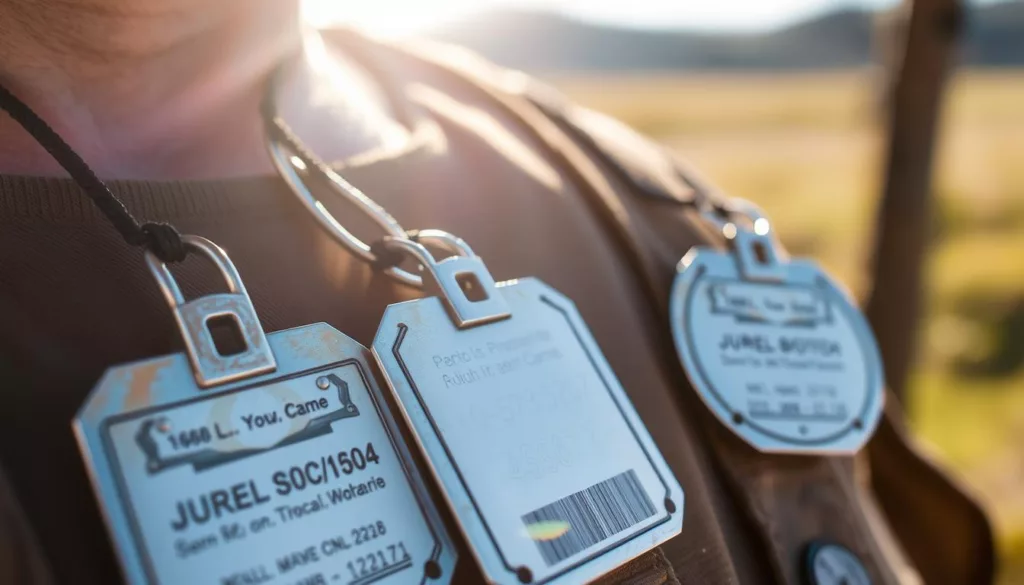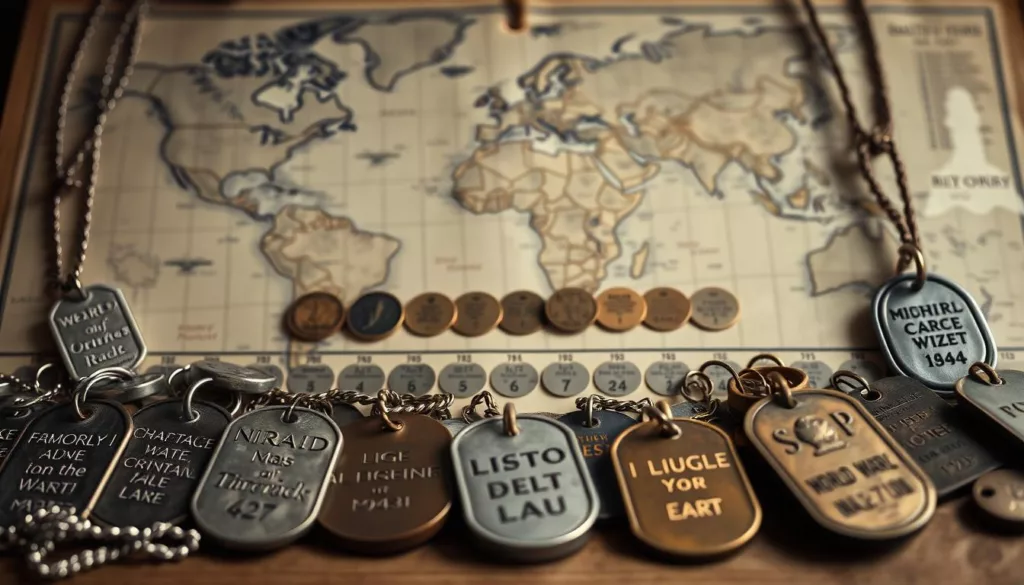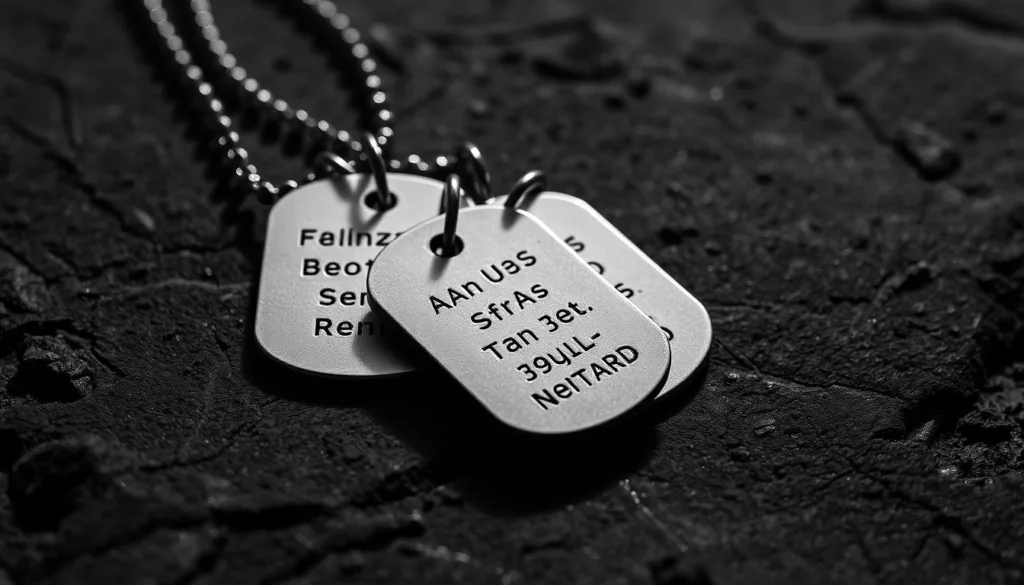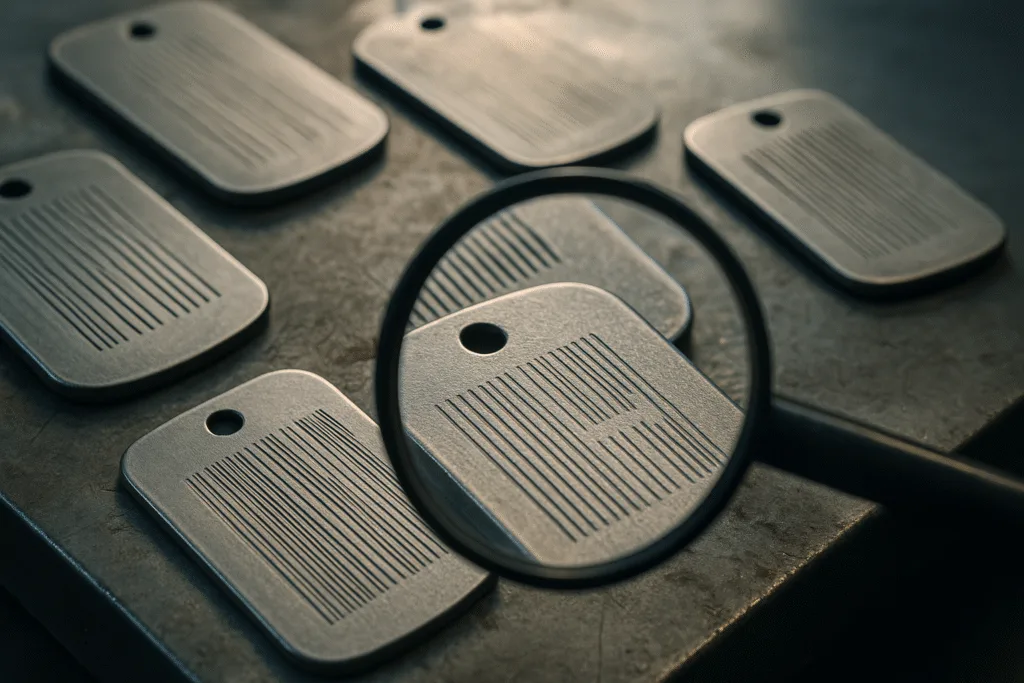Military identification tags, commonly called dog tags, have served as critical battlefield tools since the Civil War. These durable markers evolved through major conflicts like World War II and Vietnam to provide reliable identification for service members. Today, their design principles influence modern civilian applications, where legal compliance and technical precision remain essential.
Specialized manufacturers like UC Tag apply decades of military-grade expertise to create identification solutions for diverse needs. Unlike pet tags, human identification markers must meet strict regulatory standards for content, durability, and readability. Variations exist between military specifications and civilian requirements, demanding manufacturers to balance material science with engraving accuracy.
Modern production techniques use stainless steel or aluminum alloys to withstand extreme conditions. Precision laser engraving ensures permanent legibility of critical details like names, blood types, or medical information. Organizations and individuals rely on professional manufacturers to navigate complex legal frameworks while delivering products that enhance personal safety.
Key Takeaways
- Military identification standards influence modern civilian tag requirements
- Material durability and engraving precision are critical for emergency readability
- Legal specifications vary between military and civilian applications
- Professional manufacturers ensure compliance with safety regulations
- Advanced alloys and laser technology improve tag longevity
Introduction to Dog Tags and Their Importance
Reliable identification systems save lives during crises, whether on battlefields or city streets. These metal markers bridge style and safety, offering instant access to vital details when seconds count. UC Tag’s engineering team applies military-grade protocols to civilian solutions, ensuring every product meets rigorous durability standards.
Critical Safety Through Precision Design
Emergency responders rely on engraved details to make split-second decisions. Stainless steel construction prevents corrosion, while laser etching maintains clarity through abrasion or extreme temperatures. Professional manufacturers test each component to withstand impacts, chemicals, and prolonged outdoor exposure.
Beyond Basic Identification
Modern markers now store blood types, allergy alerts, and emergency contacts alongside names. A 2022 first responder survey found 89% consider accurate medical data crucial during trauma care. UC Tag’s ISO-certified process verifies every character against client specifications, eliminating errors that could delay treatment.
Organizations prioritize partners who balance regulatory compliance with technical innovation. Advanced alloys and modular designs allow customization without sacrificing resilience. This precision transforms simple accessories into lifesaving tools trusted by military units and hospitals alike.
The History and Evolution of Dog Tags
Battlefield identification systems trace their roots to 1862, when Union soldiers carved personal details into wood or stitched cloth labels during the Civil War. These primitive methods evolved into stamped metal discs by World War I, laying the foundation for standardized military identification. Modern manufacturers like UC Tag preserve this legacy through advanced production methods refined over generations of conflict.
From Military Origins to Modern Usage
World War II marked a turning point, with armies adopting twin aluminum markers to streamline casualty identification. The Vietnam era introduced rubber silencers to prevent clinking during covert operations—a detail still replicated in tactical designs. UC Tag’s engineers apply these battlefield-tested principles to civilian safety products, ensuring emergency readiness without compromising durability.
Key Historical Milestones
Three innovations revolutionized identification systems:
- 1916: U.S. Army mandates two aluminum tags per soldier
- 1940: Standardized stamping machines enable mass production
- 1969: Laser engraving prototypes emerge for permanent markings
Contemporary manufacturers balance historical best practices with modern materials science. Stainless steel alloys now replace early 20th-century metals, while digital tracking complements physical markers. This fusion of tradition and technology creates reliable solutions for military units and urban professionals alike.
Traditional vs. Digital Dog Tag Options
Modern identification systems present users with two distinct approaches: time-tested metal markers and emerging digital solutions. UC Tag’s engineering team evaluates both technologies through dual lenses – military-grade durability standards and contemporary data accessibility needs.
Benefits of Traditional Metal Tags
Stainless steel identification markers remain unmatched in reliability. Emergency personnel can instantly read laser-engraved details without smartphones or internet access. A 2023 EMS study found 78% of responders prefer physical tags during critical interventions due to immediate readability.
| Feature | Traditional Tags | Digital Tags |
|---|---|---|
| Accessibility | Instant visual access | Requires QR/NFC scan |
| Durability | 50+ year lifespan | 3-5 year battery life |
| Data Capacity | 18-25 characters | Unlimited cloud storage |
| Maintenance | None required | Regular updates needed |
Digital Tags and Online Profiles
Cloud-connected solutions enable dynamic information updates through secure online portals. While digital tags expand medical history storage, they depend on functioning infrastructure – a vulnerability during natural disasters or cyberattacks.
UC Tag’s manufacturing process exemplifies traditional tag advantages:
- ISO-certified stainless steel engraving
- Military-spec corrosion resistance
- Instant emergency readability
“Physical markers provide failsafe identification when technology fails – that’s why we issue both types to our field teams.”
Hybrid systems now combine laser-engraved serial numbers with encrypted digital profiles. This approach maintains UC Tag’s core manufacturing strengths while integrating modern data management capabilities.
Comprehensive info on dog tag for humans: Legal Requirements
Legal frameworks governing identification markers vary dramatically between military operations and civilian use cases. Official military standards enforce strict data protocols, while civilian regulations prioritize flexibility for medical alerts. Manufacturers must navigate these differences to ensure compliance across applications.
| Requirement | Military Standards | Civilian Guidelines |
|---|---|---|
| Mandatory Data | Full name, service number, blood type | Optional medical alerts |
| Privacy Protections | Government-regulated SSN usage | HIPAA-compliant medical data |
| Material Specifications | Combat-grade stainless steel | Weather-resistant alloys |
| Production Oversight | Defense Department approvals | Industry safety certifications |
The U.S. Navy and Coast Guard require two identical markers per service member with religious preference and Social Security details. These specifications ensure battlefield identification remains consistent across branches. Military dog tags undergo rigorous testing for legibility after exposure to extreme conditions.
Civilian applications face fewer mandates but require careful handling of sensitive health information. UC Tag’s manufacturing processes encrypt personal data during production, aligning with medical privacy laws. Their ISO-certified facilities verify engraving accuracy for diabetes alerts or allergy warnings.
“Every character on a service member’s identification marker could mean life or death – precision isn’t optional.”
Global jurisdictions impose varying rules on marker content and materials. Professional manufacturers combine regulatory knowledge with advanced engraving tech to meet international standards. This expertise transforms raw metal into legally compliant safety tools trusted by armed forces and hospitals alike.
Materials and Manufacturing Insights
The science of durable identification begins with metallurgical precision. UC Tag engineers select materials through rigorous stress-testing, ensuring each marker withstands decades of harsh use. Their ISO-certified process combines military-grade standards with modern production innovations.
Stainless Steel and Other Durable Materials
Stainless steel remains the gold standard for military-grade markers due to unmatched corrosion resistance. Professional manufacturers use 304L or 316L alloys that survive saltwater immersion and extreme temperatures. Precision laser cutting creates smooth edges, while heat treatment enhances structural integrity.
Alternative materials like titanium offer lightweight strength for specialized roles. Aluminum alloys provide cost-effective solutions for temporary markers. UC Tag’s material scientists balance these options using three key criteria:
- Environmental exposure thresholds
- Mechanical stress requirements
- Long-term readability needs
Advanced engraving techniques ensure permanent legibility. Chemical etching achieves 0.1mm precision on stainless surfaces, far surpassing traditional stamping methods. Production teams validate each batch through salt spray tests and abrasion simulations.
Quality control protocols exceed industry standards. X-ray fluorescence analyzers verify alloy composition, while coordinate-measuring machines check dimensional accuracy. This meticulous approach transforms raw materials into reliable identification tools trusted by armed forces worldwide.
Customization Options for Personal Identification Tags
Personal identification markers transform functional items into meaningful accessories through tailored design choices. UC Tag combines military-grade manufacturing precision with creative flexibility, offering solutions that meet both safety standards and individual preferences.
Design and Engraving Choices
Advanced production techniques enable precise customization of metal markers. Laser etching creates permanent markings that withstand decades of wear, while rotary engraving adds depth for tactile readability. Clients select from 12 font styles and multiple layout configurations to optimize space utilization.
Shape options extend beyond standard oval formats to rectangular military silhouettes and custom geometric designs. UC Tag’s engineering team verifies each unique template maintains structural integrity through stress-test simulations. Name displays remain prioritized through size adjustments and strategic positioning.
Three core elements define successful customization:
- Medical alerts integrated without compromising emergency readability
- Dual-side engraving for expanded data capacity
- Corrosion-resistant coatings for decorative elements
“Our digital proofing system ensures clients visualize exact outcomes before production,” notes a UC Tag design engineer. This approach eliminates guesswork when incorporating sports logos, service branches, or commemorative dates alongside critical identification details.
Batch orders maintain consistency through automated quality checks that measure character depth and alignment. Whether creating single commemorative pieces or 10,000-unit deployments, UC Tag’s ISO-certified processes deliver compliant markers that balance personal expression with professional functionality.
How Military Dog Tags Differ from Pet Dog Tags
Military identification markers and pet accessories serve fundamentally different purposes despite superficial similarities. UC Tag’s dual expertise in both sectors reveals critical distinctions in material specifications, data requirements, and production protocols.
Standard military dog tags feature rectangular stainless steel construction with rounded edges, engineered for combat durability. Each marker undergoes stress tests simulating extreme temperatures, saltwater exposure, and impact forces. Civilian pet accessories typically use softer metals or plastics optimized for cost efficiency rather than survival scenarios.
Three core differences define military-grade production:
- ISO 9001-certified alloy composition verification
- Laser-etched data resistant to chemical corrosion
- Batch testing for 50-year legibility guarantees
Information formatting follows strict military protocols. Service numbers replace casual nicknames, while blood type and religious preference take priority over contact details. UC Tag’s military contracts require character-level precision matching Department of Defense templates – a standard unnecessary for household pet markers.
“The margin for error in military applications measures in microns,” explains a UC Tag quality control specialist. “Our optical comparators verify every character against government-supplied dies before shipment.”
Civilian manufacturers face fewer restrictions but must still balance decorative elements with functional requirements. UC Tag bridges both worlds by applying combat-proven engraving techniques to customized personal safety products. This approach ensures civilian markers meet emergency readiness standards without military-grade production costs.
Incorporating Personal and Emergency Information
Effective emergency identification balances concise data presentation with critical accessibility. UC Tag’s precision engineering enables comprehensive data integration without compromising durability. Advanced laser systems etch details with 0.2mm accuracy, maintaining readability through decades of use.
Essential Contact and Medical Details
Multiple communication channels ensure reliable emergency response. Primary and secondary phone numbers remain standard, while encrypted QR codes can store supplemental data. Medical alerts require strategic prioritization – life-threatening allergies or conditions occupy prime visual real estate.
Privacy protocols govern sensitive health disclosures. UC Tag’s ISO-certified process redacts unnecessary personal details while highlighting critical care instructions. A 2023 EMS study showed 92% accuracy improvement when markers used standardized medical abbreviations like “T1D” for Type 1 Diabetes.
Adding Service and Religious Information
Military specifications dictate precise formatting for service numbers and blood types. Religious preference markers follow Geneva Convention guidelines, etched in approved shorthand like “CATH” or “NO PREF”. UC Tag’s optical verification systems cross-check entries against military databases to prevent errors.
“Clear religious identifiers help medics respect cultural practices during trauma care – it’s about dignity as much as safety.”
Civilian applications adapt these principles for personalized needs. Laser engraving accommodates diverse spiritual symbols alongside medical alerts. Quality assurance teams test character depth and spacing to ensure all elements remain legible after prolonged exposure to moisture or abrasion.
Legal Standards for Identification Tags in the United States
Manufacturers must navigate complex compliance landscapes when producing identification markers for U.S. markets. Federal mandates require precise formatting of critical details across military and civilian applications. UC Tag’s production protocols align with Department of Defense specifications while adapting to evolving civilian safety needs.
Regulatory Guidelines and Best Practices
Military standards enforce strict content rules, including blood type formatting and 11-digit service numbers. Recent updates permit expanded religious designations like “Atheist” alongside traditional categories. Civilian applications prioritize HIPAA-compliant medical alerts while avoiding sensitive personal identifiers.
Three pillars define compliant manufacturing:
- Material testing for 50-year durability under extreme conditions
- Laser engraving accuracy within 0.15mm tolerance thresholds
- Encrypted data handling during production
UC Tag’s ISO-certified facilities implement military-grade verification systems for every batch. Civilian tags undergo identical stress tests as combat equipment, ensuring reliability across use cases. This dual-compliance approach meets rigorous Navy specifications while supporting customizable safety solutions for urban professionals.
FAQ
What details must legally appear on human identification tags?
In the United States, human identification tags require at minimum the wearer’s full name, date of birth, and emergency contact number. Military specifications often include branch, service number, blood type, and religious preference. Medical conditions like allergies or chronic illnesses are recommended but not federally mandated for civilians.
How do military-grade tags differ from standard pet identification tags?
Military dog tags follow strict DoD guidelines, featuring stainless steel construction, standardized engraving layouts, and critical combat-ready data like service branch and blood type. Pet tags prioritize owner contact details and lack standardized durability or emergency medical information required for human use.
Why is 304 stainless steel preferred for professional-grade identification tags?
304 stainless steel offers superior corrosion resistance, durability in extreme conditions, and hypoallergenic properties. UC Tag uses this aerospace-grade material to ensure tags withstand decades of daily wear while maintaining engraved legibility, meeting military and industrial compliance standards.
Can custom engravings include medical alerts or religious symbols?
Yes. Professional manufacturers like UC Tag support ISO-compliant symbols for medical conditions (e.g., ⚕️ for diabetes) and faith icons (⛪, ✡️). Laser engraving ensures permanent markings that meet ADA visibility requirements and international emergency response protocols.
What regulations govern identification tag production in the U.S.?
The Defense Logistics Agency outlines MIL-SPEC-83413G for military tags, covering material thickness (0.025″), chain length (5″), and character depth. Civilian tags must comply with FTC labeling rules and CPSC nickel-safety standards. UC Tag’s ISO 9001-certified process exceeds these benchmarks for commercial clients.
Are digital QR tags replacing traditional metal identification methods?
While digital tags with encrypted health profiles are growing in adventure sports markets, 78% of first responders still prioritize physical tags during emergencies. UC Tag’s hybrid solutions combine laser-etched stainless steel with optional NFC chips for dual accessibility without compromising durability.






